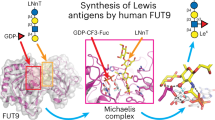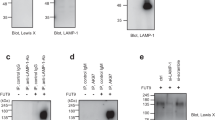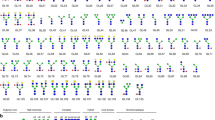Abstract
Protein O-fucosyltransferase 1 (POFUT1) fucosylates the epidermal growth factor (EGF)-like domains found in cell-surface and secreted glycoproteins including Notch and its ligands. Although Notch fucosylation is critical for development, and POFUT1 deficiency leads to human disease, how this enzyme binds and catalyzes the fucosylation of its diverse EGF-like domain substrates has not been determined. Reported here is the X-ray crystal structure of mouse POFUT1 in complex with several EGF-like domains, including EGF12 and EGF26 of Notch. Overall shape complementarity, interactions with invariant atoms of the fucosylation motif and flexible segments on POFUT1 all define its EGF-like-domain binding properties. Using large-scale structural and sequence analysis, we also show that POFUT1 binds EGF-like domains of the hEGF type and that the highly correlated presence of POFUT1 and fucosylatable hEGFs has accompanied animal evolution.
This is a preview of subscription content, access via your institution
Access options
Access Nature and 54 other Nature Portfolio journals
Get Nature+, our best-value online-access subscription
$29.99 / 30 days
cancel any time
Subscribe to this journal
Receive 12 print issues and online access
$259.00 per year
only $21.58 per issue
Buy this article
- Purchase on Springer Link
- Instant access to full article PDF
Prices may be subject to local taxes which are calculated during checkout





Similar content being viewed by others
References
Haltiwanger, R.S. Regulation of signal transduction pathways in development by glycosylation. Curr. Opin. Struct. Biol. 12, 593–598 (2002).
Stanley, P. & Okajima, T. Roles of glycosylation in Notch signaling. Curr. Top. Dev. Biol. 92, 131–164 (2010).
Rana, N.A. & Haltiwanger, R.S. Fringe benefits: functional and structural impacts of O-glycosylation on the extracellular domain of Notch receptors. Curr. Opin. Struct. Biol. 21, 583–589 (2011).
Stanley, P. & Guidos, C.J. Regulation of Notch signaling during T- and B-cell development by O-fucose glycans. Immunol. Rev. 230, 201–215 (2009).
Haines, N. & Irvine, K.D. Glycosylation regulates Notch signalling. Nat. Rev. Mol. Cell Biol. 4, 786–797 (2003).
Okajima, T. & Irvine, K.D. Regulation of notch signaling by o-linked fucose. Cell 111, 893–904 (2002).
Moloney, D.J. et al. Fringe is a glycosyltransferase that modifies Notch. Nature 406, 369–375 (2000).
Panin, V.M., Papayannopoulos, V., Wilson, R. & Irvine, K.D. Fringe modulates Notch-ligand interactions. Nature 387, 908–912 (1997).
Li, Y., Lei, L., Irvine, K.D. & Baker, N.E. Notch activity in neural cells triggered by a mutant allele with altered glycosylation. Development 130, 2829–2840 (2003).
Shi, S. & Stanley, P. Protein O-fucosyltransferase 1 is an essential component of Notch signaling pathways. Proc. Natl. Acad. Sci. USA 100, 5234–5239 (2003).
Tsao, P.N. et al. Notch signaling prevents mucous metaplasia in mouse conducting airways during postnatal development. Development 138, 3533–3543 (2011).
Yan, Q. et al. O-fucose modulates Notch-controlled blood lineage commitment. Am. J. Pathol. 176, 2921–2934 (2010).
Yao, D. et al. Protein O-fucosyltransferase 1 (Pofut1) regulates lymphoid and myeloid homeostasis through modulation of Notch receptor ligand interactions. Blood 117, 5652–5662 (2011).
Li, M. et al. Mutations in POFUT1, encoding protein O-fucosyltransferase 1, cause generalized Dowling-Degos disease. Am. J. Hum. Genet. 92, 895–903 (2013).
Bernardo, B.C. et al. Therapeutic inhibition of the miR-34 family attenuates pathological cardiac remodeling and improves heart function. Proc. Natl. Acad. Sci. USA 109, 17615–17620 (2012).
Yokota, S. et al. Protein O-fucosyltransferase 1: a potential diagnostic marker and therapeutic target for human oral cancer. Int. J. Oncol. 43, 1864–1870 (2013).
Milde-Langosch, K. et al. Prognostic relevance of glycosylation-associated genes in breast cancer. Breast Cancer Res. Treat. 145, 295–305 (2014).
Wouters, M.A. et al. Evolution of distinct EGF domains with specific functions. Protein Sci. 14, 1091–1103 (2005).
Rampal, R., Arboleda-Velasquez, J.F., Nita-Lazar, A., Kosik, K.S. & Haltiwanger, R.S. Highly conserved O-fucose sites have distinct effects on Notch1 function. J. Biol. Chem. 280, 32133–32140 (2005).
Wang, Y. & Spellman, M.W. Purification and characterization of a GDP-fucose:polypeptide fucosyltransferase from Chinese hamster ovary cells. J. Biol. Chem. 273, 8112–8118 (1998).
Martinez-Duncker, I., Mollicone, R., Candelier, J.J., Breton, C. & Oriol, R. A new superfamily of protein-O-fucosyltransferases, alpha2-fucosyltransferases, and alpha6-fucosyltransferases: phylogeny and identification of conserved peptide motifs. Glycobiology 13, 1C–5C (2003).
Acar, M. et al. Rumi is a CAP10 domain glycosyltransferase that modifies Notch and is required for Notch signaling. Cell 132, 247–258 (2008).
Luo, Y., Nita-Lazar, A. & Haltiwanger, R.S. Two distinct pathways for O-fucosylation of epidermal growth factor-like or thrombospondin type 1 repeats. J. Biol. Chem. 281, 9385–9392 (2006).
Okajima, T., Xu, A., Lei, L. & Irvine, K.D. Chaperone activity of protein O-fucosyltransferase 1 promotes notch receptor folding. Science 307, 1599–1603 (2005).
Luo, Y. & Haltiwanger, R.S. O-fucosylation of notch occurs in the endoplasmic reticulum. J. Biol. Chem. 280, 11289–11294 (2005).
Vasudevan, D. & Haltiwanger, R.S. Novel roles for O-linked glycans in protein folding. Glycoconj. J. 31, 417–426 (2014).
Lira-Navarrete, E. et al. Structural insights into the mechanism of protein O-fucosylation. PLoS One 6, e25365 (2011).
Coutinho, P.M., Deleury, E., Davies, G.J. & Henrissat, B. An evolving hierarchical family classification for glycosyltransferases. J. Mol. Biol. 328, 307–317 (2003).
Lawrence, M.C. & Colman, P.M. Shape complementarity at protein/protein interfaces. J. Mol. Biol. 234, 946–950 (1993).
Ysern, X., Li, H. & Mariuzza, R.A. Imperfect interfaces. Nat. Struct. Biol. 5, 412–414 (1998).
Lei, L., Xu, A., Panin, V.M. & Irvine, K.D. An O-fucose site in the ligand binding domain inhibits Notch activation. Development 130, 6411–6421 (2003).
Valero-González, J. et al. A proactive role of water molecules in acceptor recognition by protein O-fucosyltransferase 2. Nat. Chem. Biol. 12, 240–246 (2016).
Lairson, L.L., Henrissat, B., Davies, G.J. & Withers, S.G. Glycosyltransferases: structures, functions, and mechanisms. Annu. Rev. Biochem. 77, 521–555 (2008).
Lazarus, M.B., Nam, Y., Jiang, J., Sliz, P. & Walker, S. Structure of human O-GlcNAc transferase and its complex with a peptide substrate. Nature 469, 564–567 (2011).
Abbott, D.W., Macauley, M.S., Vocadlo, D.J. & Boraston, A.B. Streptococcus pneumoniae endohexosaminidase D, structural and mechanistic insight into substrate-assisted catalysis in family 85 glycoside hydrolases. J. Biol. Chem. 284, 11676–11689 (2009).
Tvaroška, I. Atomistic insight into the catalytic mechanism of glycosyltransferases by combined quantum mechanics/molecular mechanics (QM/MM) methods. Carbohydr. Res. 403, 38–47 (2015).
Rini, J., Esko, J. & Varki, A. Glycosyltransferases and glycan-processing enzymes. in Essentials of Glycobiology (eds. Varki, A. et al.) (Cold Spring Harbor, New York, USA, 2009).
Matsuura, A. et al. O-linked N-acetylglucosamine is present on the extracellular domain of notch receptors. J. Biol. Chem. 283, 35486–35495 (2008).
Cordle, J. et al. A conserved face of the Jagged/Serrate DSL domain is involved in Notch trans-activation and cis-inhibition. Nat. Struct. Mol. Biol. 15, 849–857 (2008).
Ringrose, J.H. et al. Deep proteome profiling of Trichoplax adhaerens reveals remarkable features at the origin of metazoan multicellularity. Nat. Commun. 4, 1408 (2013).
Chen, C.I. et al. Structure of human POFUT2: insights into thrombospondin type 1 repeat fold and O-fucosylation. EMBO J. 31, 3183–3197 (2012).
Sigrist, C.J. et al. New and continuing developments at PROSITE. Nucleic Acids Res. 41, D344–D347 (2013).
Krissinel, E. Enhanced fold recognition using efficient short fragment clustering. J. Mol. Biochem. 1, 76–85 (2012).
Li, Z., Michael, I.P., Zhou, D., Nagy, A. & Rini, J.M. Simple piggyBac transposon-based mammalian cell expression system for inducible protein production. Proc. Natl. Acad. Sci. USA 110, 5004–5009 (2013).
Reeves, P.J., Callewaert, N., Contreras, R. & Khorana, H.G. Structure and function in rhodopsin: high-level expression of rhodopsin with restricted and homogeneous N-glycosylation by a tetracycline-inducible N-acetylglucosaminyltransferase I-negative HEK293S stable mammalian cell line. Proc. Natl. Acad. Sci. USA 99, 13419–13424 (2002).
Robbins, P.W. et al. Primary structure of the Streptomyces enzyme endo-β-N-acetylglucosaminidase H. J. Biol. Chem. 259, 7577–7583 (1984).
Takegawa, K., Nakoshi, M., Iwahara, S., Yamamoto, K. & Tochikura, T. Induction and purification of endo-β-N-acetylglucosaminidase from Arthrobacter protophormiae grown in ovalbumin. Appl. Environ. Microbiol. 55, 3107–3112 (1989).
Sheldrick, G.M. A short history of SHELX. Acta Crystallogr. A 64, 112–122 (2008).
Emsley, P., Lohkamp, B., Scott, W.G. & Cowtan, K. Features and development of Coot. Acta Crystallogr. D Biol. Crystallogr. 66, 486–501 (2010).
Murshudov, G.N., Vagin, A.A. & Dodson, E.J. Refinement of macromolecular structures by the maximum-likelihood method. Acta Crystallogr. D Biol. Crystallogr. 53, 240–255 (1997).
Adams, P.D. et al. PHENIX: a comprehensive Python-based system for macromolecular structure solution. Acta Crystallogr. D Biol. Crystallogr. 66, 213–221 (2010).
Abdiche, Y., Malashock, D., Pinkerton, A. & Pons, J. Determining kinetics and affinities of protein interactions using a parallel real-time label-free biosensor, the Octet. Anal. Biochem. 377, 209–217 (2008).
Gosselin, S., Alhussaini, M., Streiff, M.B., Takabayashi, K. & Palcic, M.M. A continuous spectrophotometric assay for glycosyltransferases. Anal. Biochem. 220, 92–97 (1994).
Duggleby, R.G. Analysis of enzyme progress curves by nonlinear regression. Methods Enzymol. 249, 61–90 (1995).
Kuzmic, P. Program DYNAFIT for the analysis of enzyme kinetic data: application to HIV proteinase. Anal. Biochem. 237, 260–273 (1996).
Kelley, L.A., Mezulis, S., Yates, C.M., Wass, M.N. & Sternberg, M.J. The Phyre2 web portal for protein modeling, prediction and analysis. Nat. Protoc. 10, 845–858 (2015).
Ashkenazy, H., Erez, E., Martz, E., Pupko, T. & Ben-Tal, N. ConSurf 2010: calculating evolutionary conservation in sequence and structure of proteins and nucleic acids. Nucleic Acids Res. 38, W529–W533 (2010).
Pettersen, E.F. et al. UCSF Chimera--a visualization system for exploratory research and analysis. J. Comput. Chem. 25, 1605–1612 (2004).
Krissinel, E. & Henrick, K. Inference of macromolecular assemblies from crystalline state. J. Mol.Biol. 372, 774–797 (2007).
Laskowski, R.A. & Swindells, M.B. LigPlot+: multiple ligand-protein interaction diagrams for drug discovery. J. Chem. Inf. Model 51, 2778–2786 (2011).
Acknowledgements
This work was supported by a grant to J.M.R. from the Canadian Institutes of Health Research, Funding Reference Number MOP-125956. X-ray crystallographic data were collected at beamline 08ID-1 at the Canadian Light Source. We also thank the Canadian Macromolecular Crystallography Facility staff for the mail-in data that were collected.
Author information
Authors and Affiliations
Contributions
Z.L., J.E.P. and J.M.R. designed the research. Z.L., K.H., J.E.P. and M.S. performed the experiments. Z.L. carried out the bioinformatic and structural studies. M.S. and D.Z. provided technical assistance. Z.L. and J.M.R. wrote the manuscript.
Corresponding author
Ethics declarations
Competing interests
The authors declare no competing financial interests.
Supplementary information
Supplementary Text and Figures
Supplementary Results, Supplementary Tables 1–8 and Supplementary Figures 1–14 (PDF 13616 kb)
Supplementary Dataset 1
Statistics for the distribution of EGF-like domain (EGF-LD) types and Ofucosylation motifs in 339 animal species (PDF 7901 kb)
Rights and permissions
About this article
Cite this article
Li, Z., Han, K., Pak, J. et al. Recognition of EGF-like domains by the Notch-modifying O-fucosyltransferase POFUT1. Nat Chem Biol 13, 757–763 (2017). https://doi.org/10.1038/nchembio.2381
Received:
Accepted:
Published:
Issue Date:
DOI: https://doi.org/10.1038/nchembio.2381
This article is cited by
-
α1,3-fucosylation of MEST promotes invasion potential of cytotrophoblast cells by activating translation initiation
Cell Death & Disease (2023)
-
Structural basis for heparan sulfate co-polymerase action by the EXT1–2 complex
Nature Chemical Biology (2023)
-
1H, 15N, 13C backbone and sidechain resonance assignments and secondary structure of mouse NOTCH1 EGF27
Biomolecular NMR Assignments (2023)
-
Preliminary study on the mechanism of POFUT1 in colorectal cancer
Medical Oncology (2023)
-
Structural insights into mechanism and specificity of the plant protein O-fucosyltransferase SPINDLY
Nature Communications (2022)



